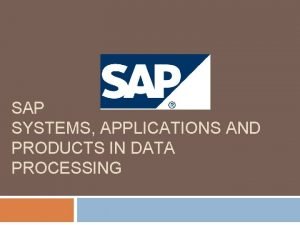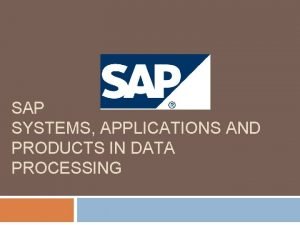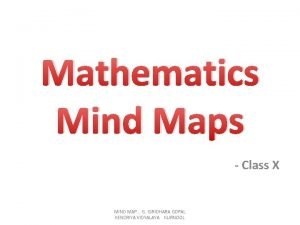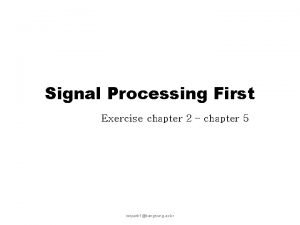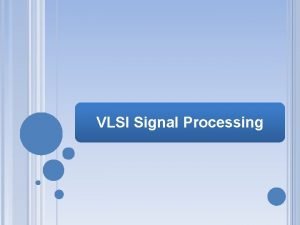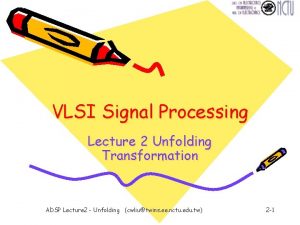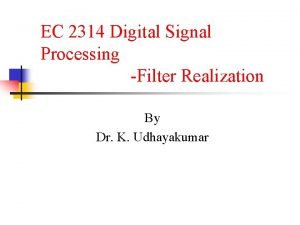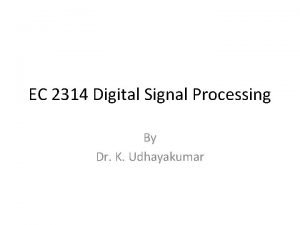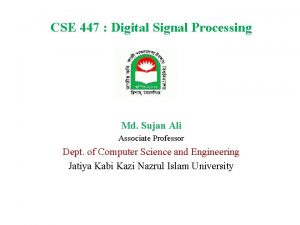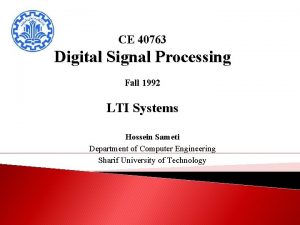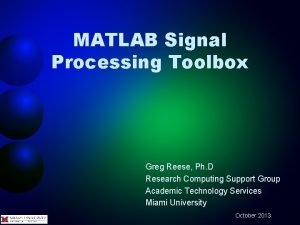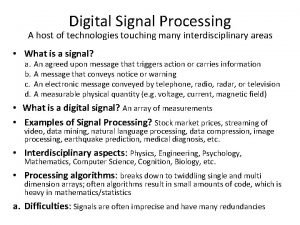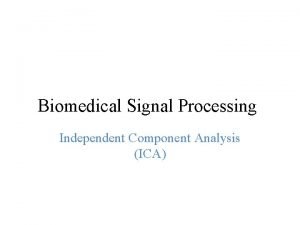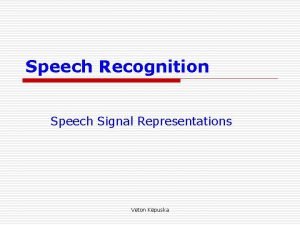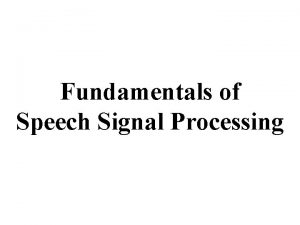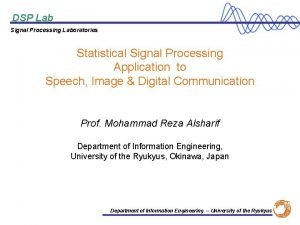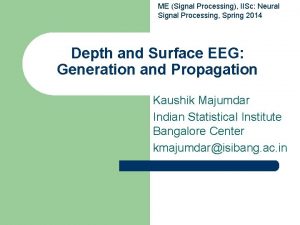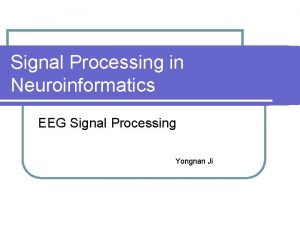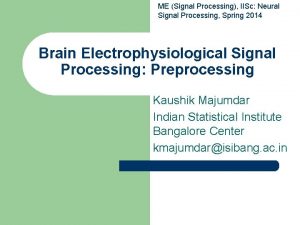SIGNAL PROCESSING SOME APPLICATIONS IN SPEECH MUSIC and









![Linear filtering the waveform y[n] x[n] Filter 1: y[n] = 3. 6 y[n– 1]+5. Linear filtering the waveform y[n] x[n] Filter 1: y[n] = 3. 6 y[n– 1]+5.](https://slidetodoc.com/presentation_image/e1b528de4770ee2070ffca71c5597daf/image-10.jpg)










- Slides: 20

SIGNAL PROCESSING: SOME APPLICATIONS IN SPEECH, MUSIC, and IMAGE PROCESSING Richard M. Stern 18 -396 demo January 12, 2009 Department of Electrical and Computer Engineering and School of Computer Science Carnegie Mellon University Pittsburgh, Pennsylvania 15213

What is signal processing? Oppenheim and Schafer’s definition (1999): – [The discipline that is concerned with] the representation, transformation, and manipulation of signals and the information they contain Carnegie Mellon Slide 2 18 -396 Signals and Systems

Why perform signal processing? To understand the content of signals To represent signals in a form that is more insightful to us To transform signals into a form that is more useful to us Carnegie Mellon Slide 3 18 -396 Signals and Systems

Representation of speech in time domain Carnegie Mellon Slide 4 18 -396 Signals and Systems

Representation of speech in frequency domain Carnegie Mellon Slide 5 18 -396 Signals and Systems

Signal representation: turning sine waves into square waves Carnegie Mellon Slide 6 18 -396 Signals and Systems

Signal processing in human speech production: the source-filter model of speech A useful model for representing the generation of speech sounds: Amplitude Pitch Pulse train source p[n] Vocal tract model Noise source Carnegie Mellon Slide 7 18 -396 Signals and Systems

Speech coding: separating the vocal tract excitation and filter Original speech: Speech with 75 -Hz excitation: Speech with 150 Hz excitation: Speech with noise excitation: Carnegie Mellon Slide 8 18 -396 Signals and Systems

Representation and filtering of speech sounds Carnegie Mellon Slide 9 18 -396 Signals and Systems
![Linear filtering the waveform yn xn Filter 1 yn 3 6 yn 15 Linear filtering the waveform y[n] x[n] Filter 1: y[n] = 3. 6 y[n– 1]+5.](https://slidetodoc.com/presentation_image/e1b528de4770ee2070ffca71c5597daf/image-10.jpg)
Linear filtering the waveform y[n] x[n] Filter 1: y[n] = 3. 6 y[n– 1]+5. 0 y[n– 2]– 3. 2 y[n– 3]+. 82 y[n– 4] +. 013 x[n]–. 032 x[n– 1]+. 044 x[n– 2]–. 033 x[n– 3]+. 013 x[n– 4] Filter 2: y[n] = 2. 7 y[n– 1]– 3. 3 y[n– 2]+2. 0 y[n– 3–. 57 y[n– 4] +. 35 x[n]– 1. 3 x[n– 1]+2. 0 x[n– 2]– 1. 3 x[n– 3]+. 35 x[n– 4] Carnegie Mellon Slide 10 18 -396 Signals and Systems

Filter 1 in the time domain Carnegie Mellon Slide 11 18 -396 Signals and Systems

Output of Filter 1 in the frequency domain Original: Lowpass: Carnegie Mellon Slide 12 18 -396 Signals and Systems

Filter 2 in the time domain Carnegie Mellon Slide 13 18 -396 Signals and Systems

Output of Filter 2 in the frequency domain Original: Highpass: Carnegie Mellon Slide 14 18 -396 Signals and Systems

What happens when we filter images? Carnegie Mellon Slide 15 18 -396 Signals and Systems

Lowpass filtering with a Gaussian kernel …. Carnegie Mellon Slide 16 18 -396 Signals and Systems

Not enough blur? ? Carnegie Mellon Slide 17 18 -396 Signals and Systems

We can also highpass filter …. Carnegie Mellon Slide 18 18 -396 Signals and Systems

… and threshold to detect the image edges Carnegie Mellon Slide 19 18 -396 Signals and Systems

 Music music music
Music music music Baseband signal and bandpass signal
Baseband signal and bandpass signal Baseband signal and bandpass signal
Baseband signal and bandpass signal Classification of signal
Classification of signal Digital signal as a composite analog signal
Digital signal as a composite analog signal Systems applications and products
Systems applications and products Systems applications and products in data processing
Systems applications and products in data processing Applications and processing of metal alloys
Applications and processing of metal alloys What are some contact forces and some noncontact forces
What are some contact forces and some noncontact forces Some may trust in horses
Some may trust in horses Mind map for trigonometry class 10
Mind map for trigonometry class 10 Signal processing first
Signal processing first Parallel system tsample tclock
Parallel system tsample tclock Unfolding in vlsi signal processing
Unfolding in vlsi signal processing Direct form 2 structure
Direct form 2 structure Ec2314 digital signal processing
Ec2314 digital signal processing Dr sujan ali
Dr sujan ali Digital signal processing
Digital signal processing Matlab signal processing toolbox
Matlab signal processing toolbox Complex wave
Complex wave Pca vs ica
Pca vs ica





